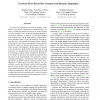Free Online Productivity Tools
i2Speak
i2Symbol
i2OCR
iTex2Img
iWeb2Print
iWeb2Shot
i2Type
iPdf2Split
iPdf2Merge
i2Bopomofo
i2Arabic
i2Style
i2Image
i2PDF
iLatex2Rtf
Sci2ools
CVPR
2012
IEEE
2012
IEEE
Geodesic flow kernel for unsupervised domain adaptation
In real-world applications of visual recognition, many factors—such as pose, illumination, or image quality—can cause a significant mismatch between the source domain on which classifiers are trained and the target domain to which those classifiers are applied. As such, the classifiers often perform poorly on the target domain. Domain adaptation techniques aim to correct the mismatch. Existing approaches have concentrated on learning feature representations that are invariant across domains, and they often do not directly exploit low-dimensional structures that are intrinsic to many vision datasets. In this paper, we propose a new kernel-based method that takes advantage of such structures. Our geodesic flow kernel models domain shift by integrating an infinite number of subspaces that characterize changes in geometric and statistical properties from the source to the target domain. Our approach is computationally advantageous, automatically inferring important algorithmic p...
| Added | 28 Sep 2012 |
| Updated | 28 Sep 2012 |
| Type | Journal |
| Year | 2012 |
| Where | CVPR |
| Authors | Boqing Gong, Yuan Shi, Fei Sha, Kristen Grauman |
Comments (0)

